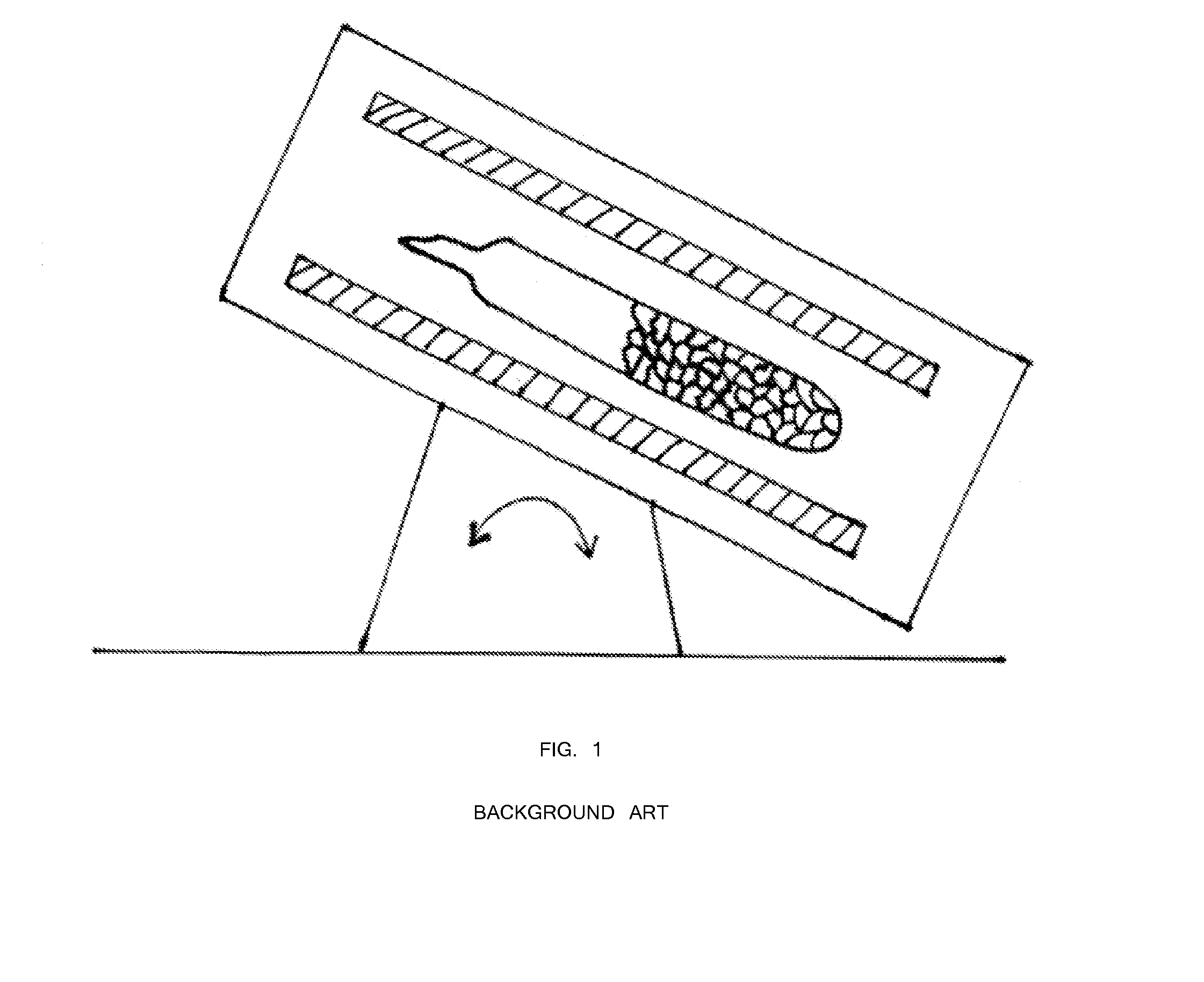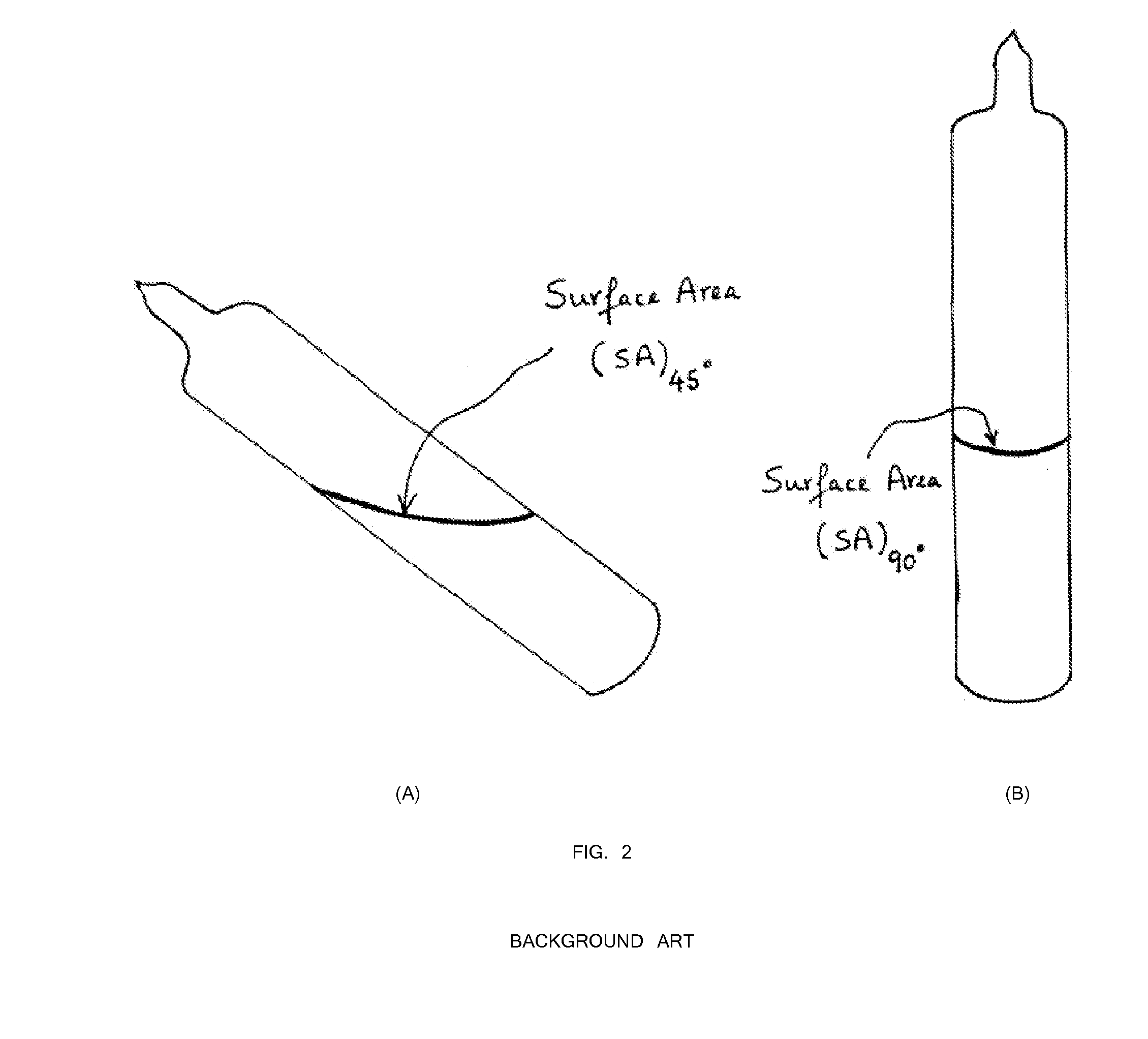Manufacturing process for chalcogenide glasses
a technology of chalcogenide glasses and manufacturing process, which is applied in the field of making chalcogenide glasses, can solve the problems of typical refractive index perturbations observed in these glasses, unstable and viscous state near the top of the glass melt is frozen in place, and the top of the glass melt undergoes turbulent viscosity flow, etc., to achieve the effect of reducing the stress of quenching, reducing the energy and stable state of the glass melt, and reducing the stress of th
- Summary
- Abstract
- Description
- Claims
- Application Information
AI Technical Summary
Benefits of technology
Problems solved by technology
Method used
Image
Examples
example 1
Example of Material Involving Stable Chalcogenide Glasses
[0040]First, 47.92 grams of arsenic and 32.08 grams of sulfur precursors (a total of 80 grams) were batched in a silica ampoule with a composition of As39S61. The ampoule was evacuated for 4 hours at 1×10−5 Torr. The ampoule was sealed using a methane / oxygen torch. Inside a rocking furnace with a 45 degree angle inclination, the ampoule containing the arsenic and sulfur precursors was melted at 450° C. for 4 hours. For homogenization mixing and uniform glass melting, the temperature was increased to 600° C. for 4 hours and 800° C. for 10 hours. Next, the rocking furnace was set at a 45 degree inclination and the temperature was lowered to 700° C. for 1 hour. The ampoule was transferred from the 45 degree furnace into another vertically 90° furnace with the temperature set at 700° C. (FIG. 4). The temperature of the vertical furnace was set at 700° C. for 1 hour for homogenization and uniform mixing. Next, the temperature of th...
example 2
Example of Material Involving Rare-Earth Doped Chalcogenide Glasses
[0046]Oxide impurities present in the starting components (germanium, arsenic, and selenium) were removed by melting the precursors with the addition of 10 ppm of aluminum, zirconium, magnesium, or any combination thereof. First, 14.905 grams of germanium, 13.631 grams of arsenic, 51.102 grams of selenium, and 0.008 grams of aluminum precursors (approximately 79.646 grams) were batched in a silica ampoule in chamber A (FIG. 6). Table 2 shows the typical batch size to make about 80 grams of core cullet. The ampoule was evacuated for 4 hours at 1×10−5 Torr. The ampoule was sealed using a methane / oxygen torch.
TABLE 2Batch calculations for making ~80 grams of core cullet rare-earth dopedglass rod with Ge19.75As17.5Ga0.5Se62.25 composition80 gMol %Mol. Wt.batchGe19.75072.5914.905As17.50074.92213.631Ga0.50069.720.362Se62.25078.9651.102100.000~80.000
[0047]The ampoule (chamber A) was placed in the first zone of a two-zone fu...
example 3
Example of Material Involving Unstable Undoped Chalcogenide Glasses
[0053]Optical fiber cladding material for unstable rare-earth doped chalcogenide glasses are often made using unstable undoped chalcogenide glasses. The unstable glasses require a similar technique for purification and cooling. The oxide removal process is similar to the oxide removal step used for making the rare-earth doped core material discussed in Example 2 above. The oxide impurities present in the starting components (germanium, arsenic and selenium) are removed by melting the precursors with the addition of 10 ppm of aluminum. First, 14.935 grams of germanium, 14.230 grams of arsenic, 49.989 grams of selenium, and 0.008 grams of aluminum precursors (approximately 79.162 grams) were batched in a silica ampoule. Table 6 shows the typical batch size to make a 79.162 gram clad cullet. The ampoule was evacuated for 4 hours at 1×10−5 Torr. The ampoule was sealed using a methane / oxygen torch.
TABLE 6Batch calculation...
PUM
| Property | Measurement | Unit |
|---|---|---|
| glass transition temperature | aaaaa | aaaaa |
| temperature | aaaaa | aaaaa |
| inclination angle | aaaaa | aaaaa |
Abstract
Description
Claims
Application Information
 Login to View More
Login to View More - R&D
- Intellectual Property
- Life Sciences
- Materials
- Tech Scout
- Unparalleled Data Quality
- Higher Quality Content
- 60% Fewer Hallucinations
Browse by: Latest US Patents, China's latest patents, Technical Efficacy Thesaurus, Application Domain, Technology Topic, Popular Technical Reports.
© 2025 PatSnap. All rights reserved.Legal|Privacy policy|Modern Slavery Act Transparency Statement|Sitemap|About US| Contact US: help@patsnap.com



